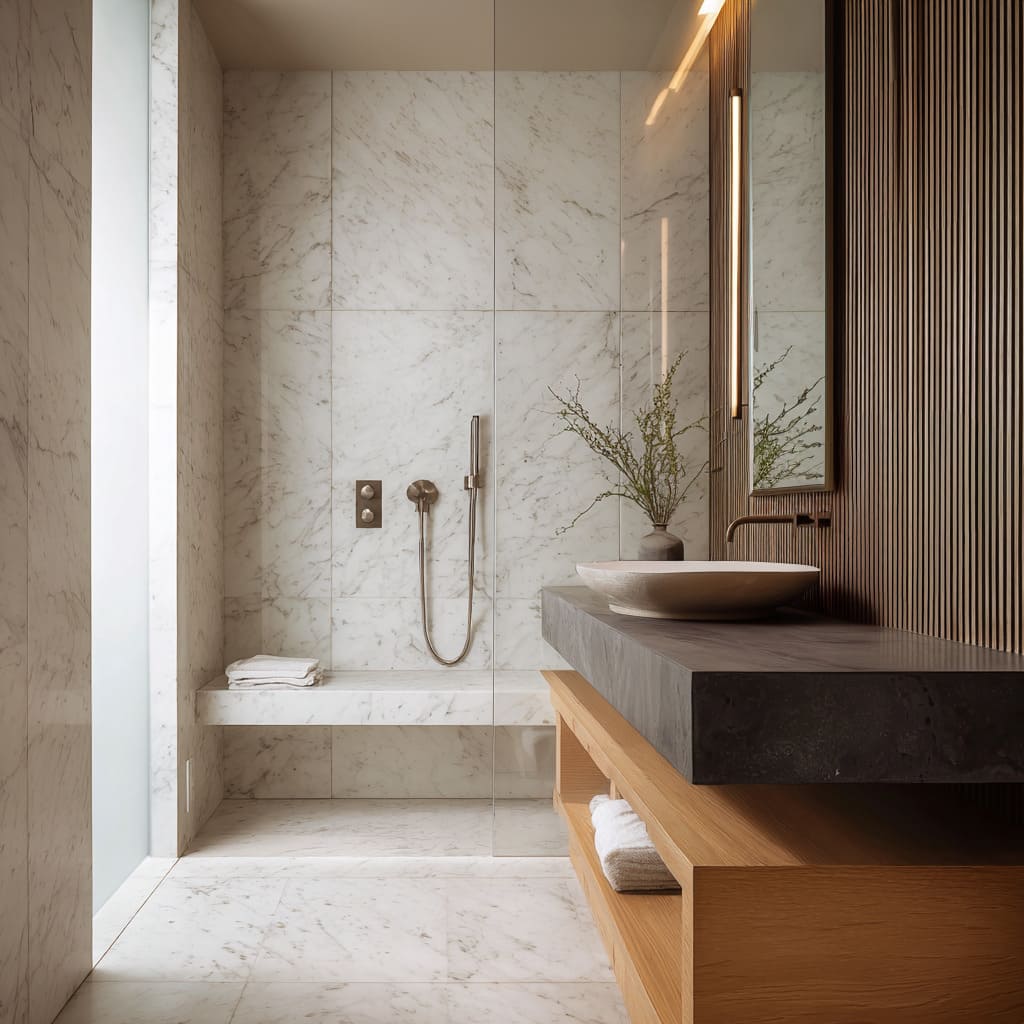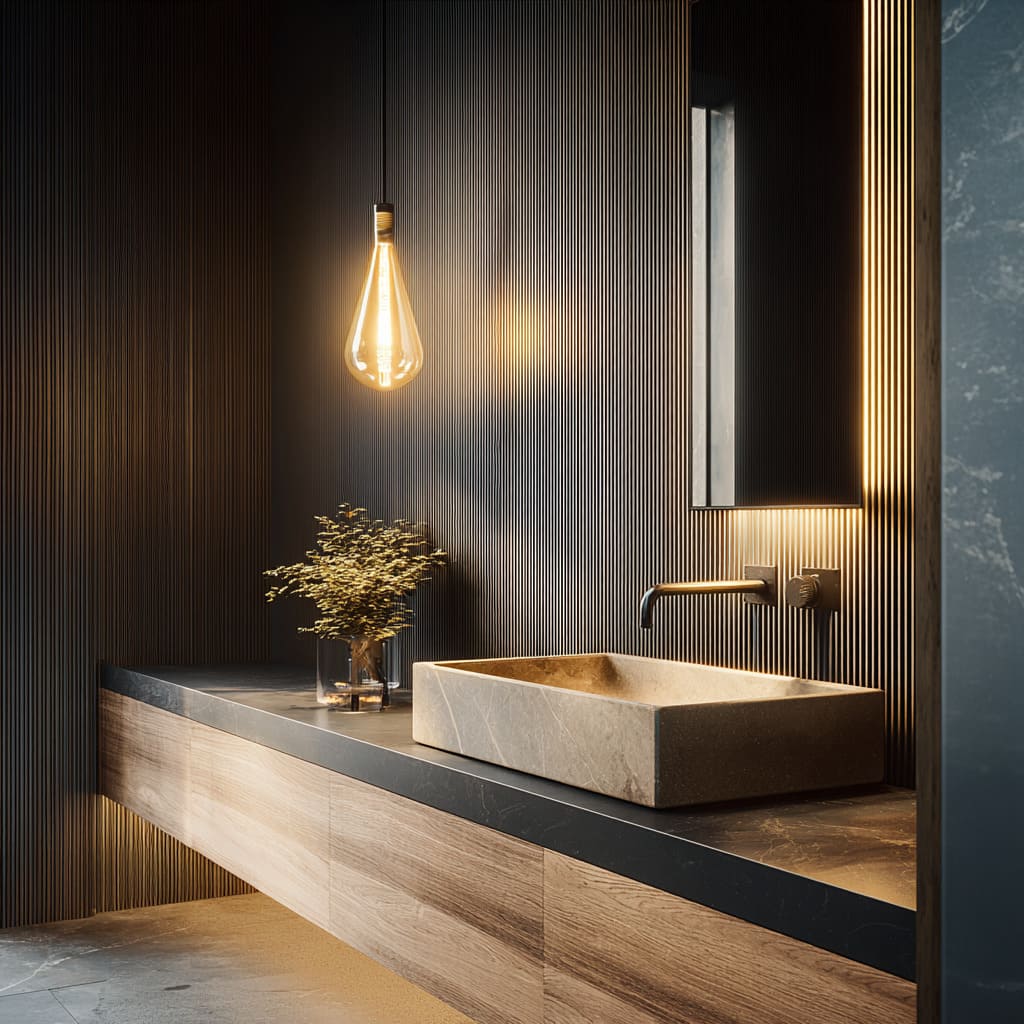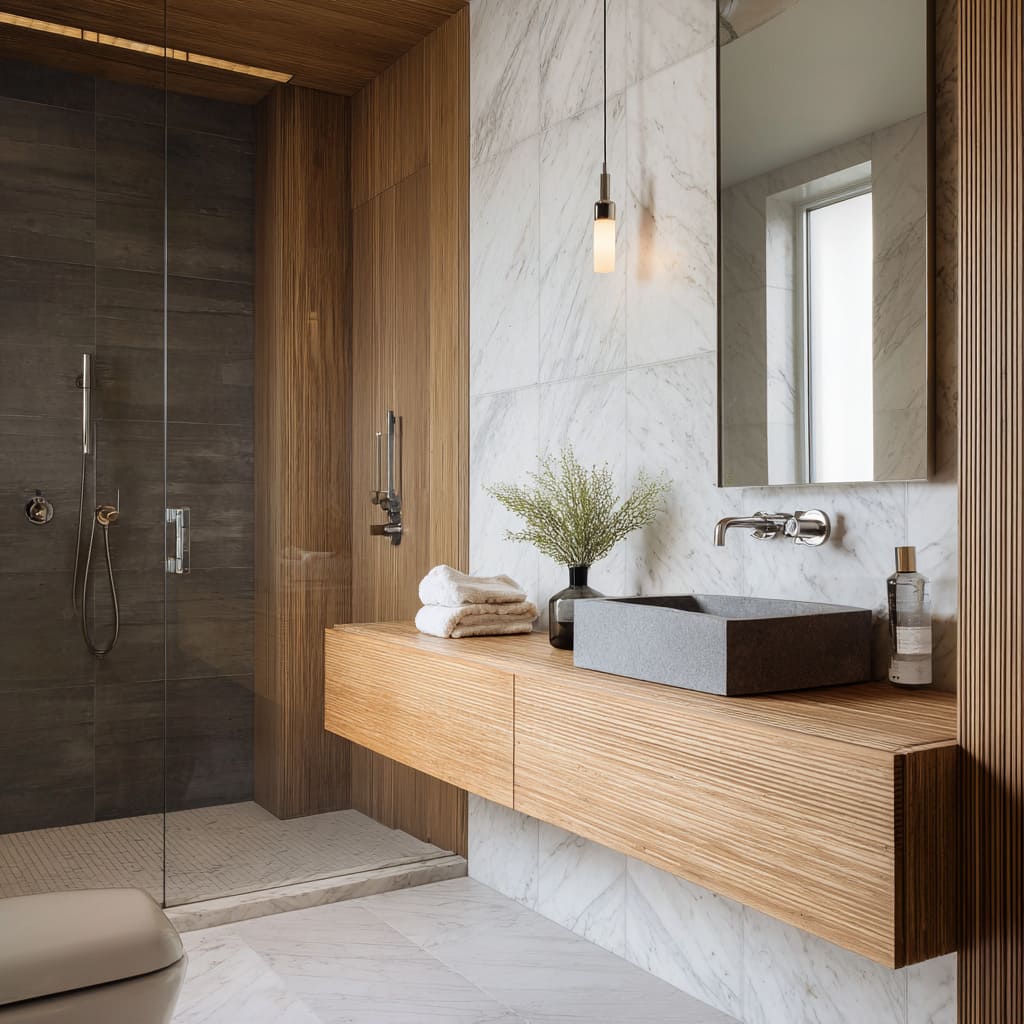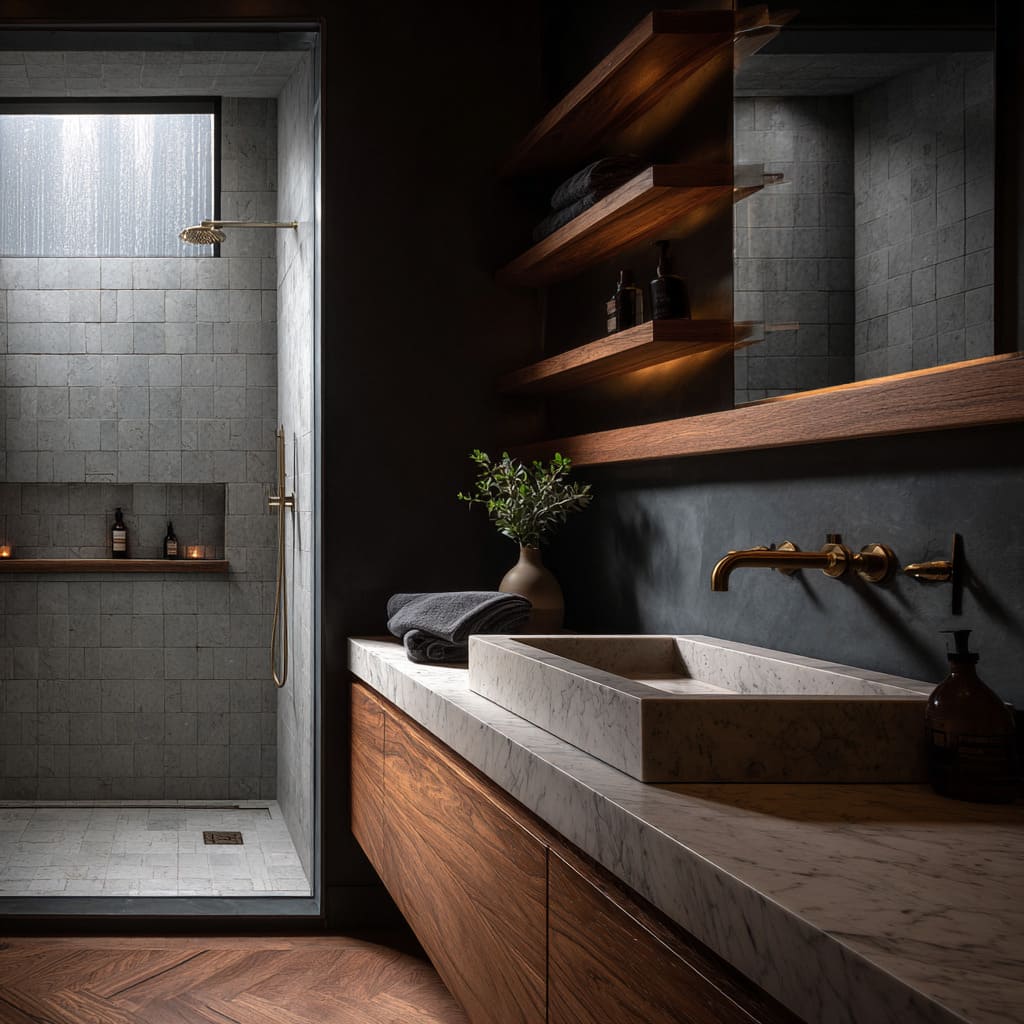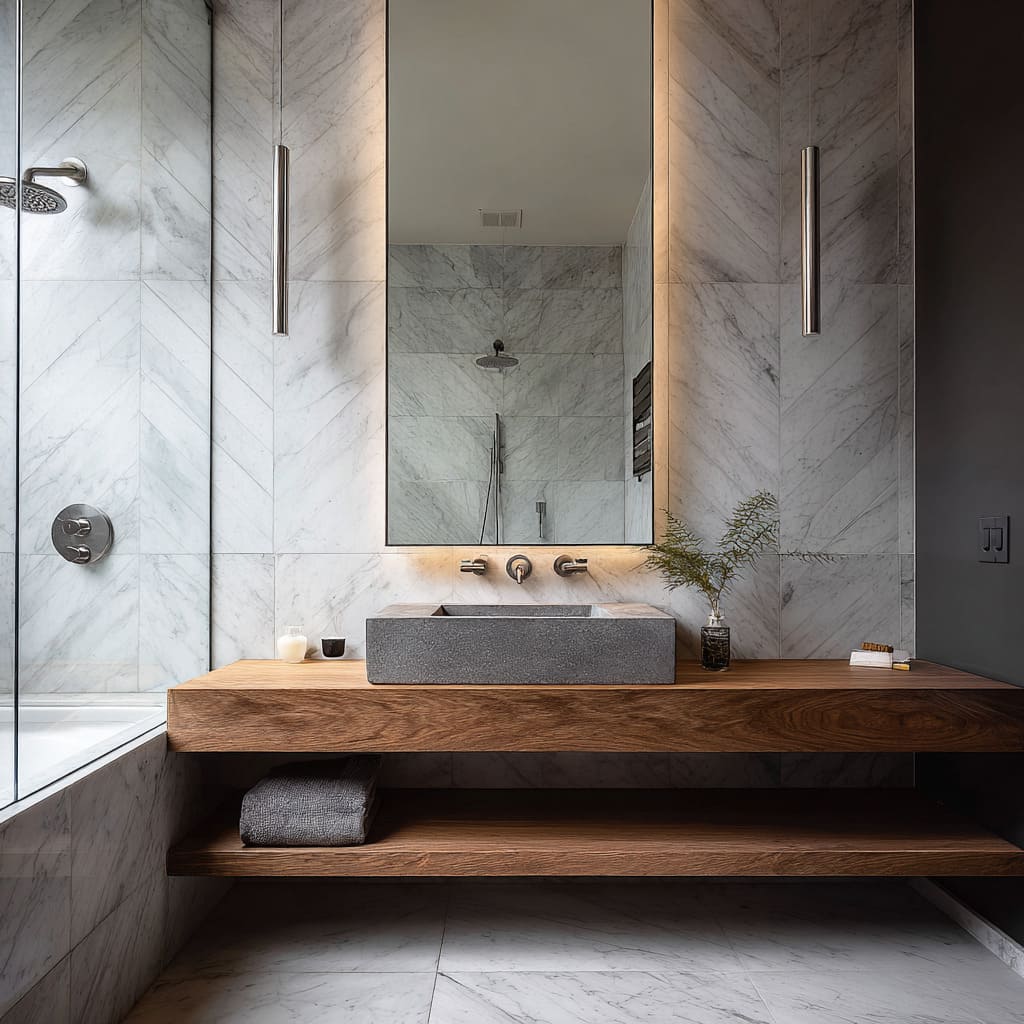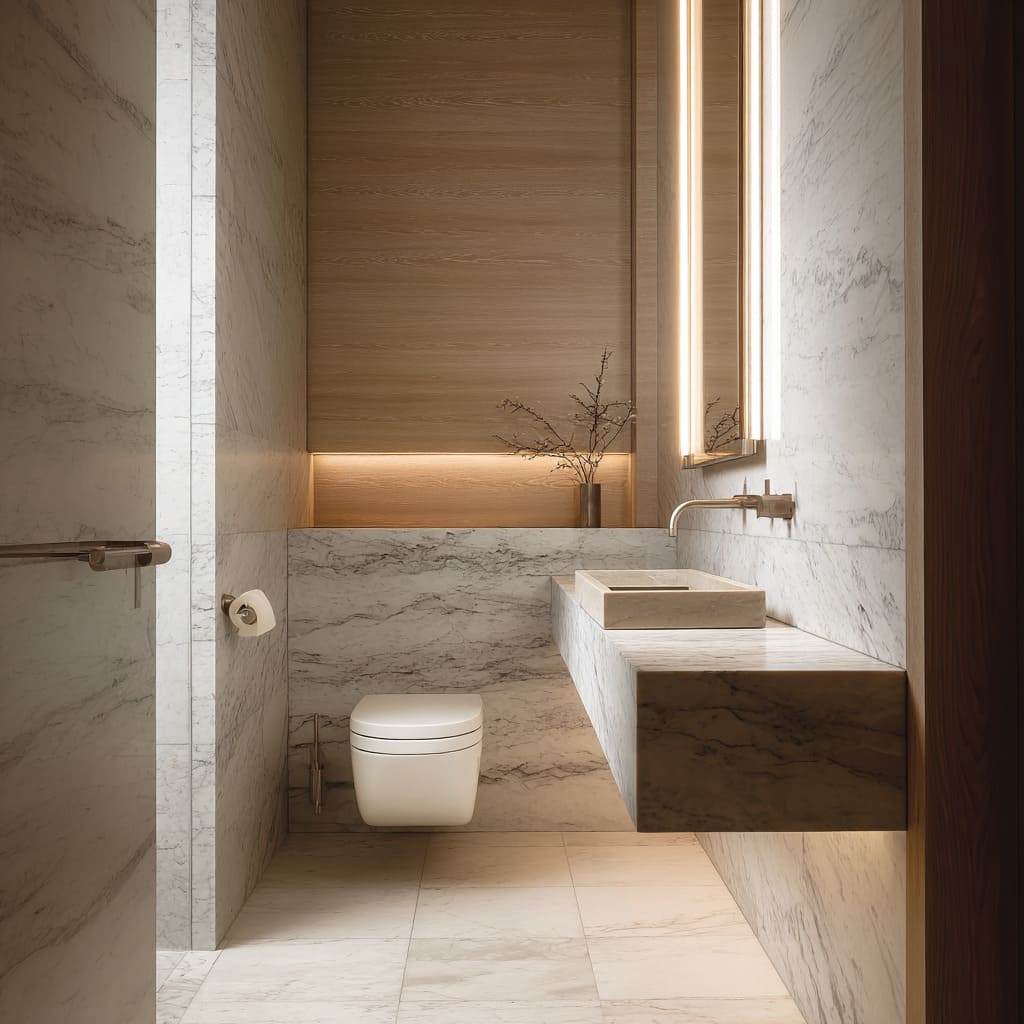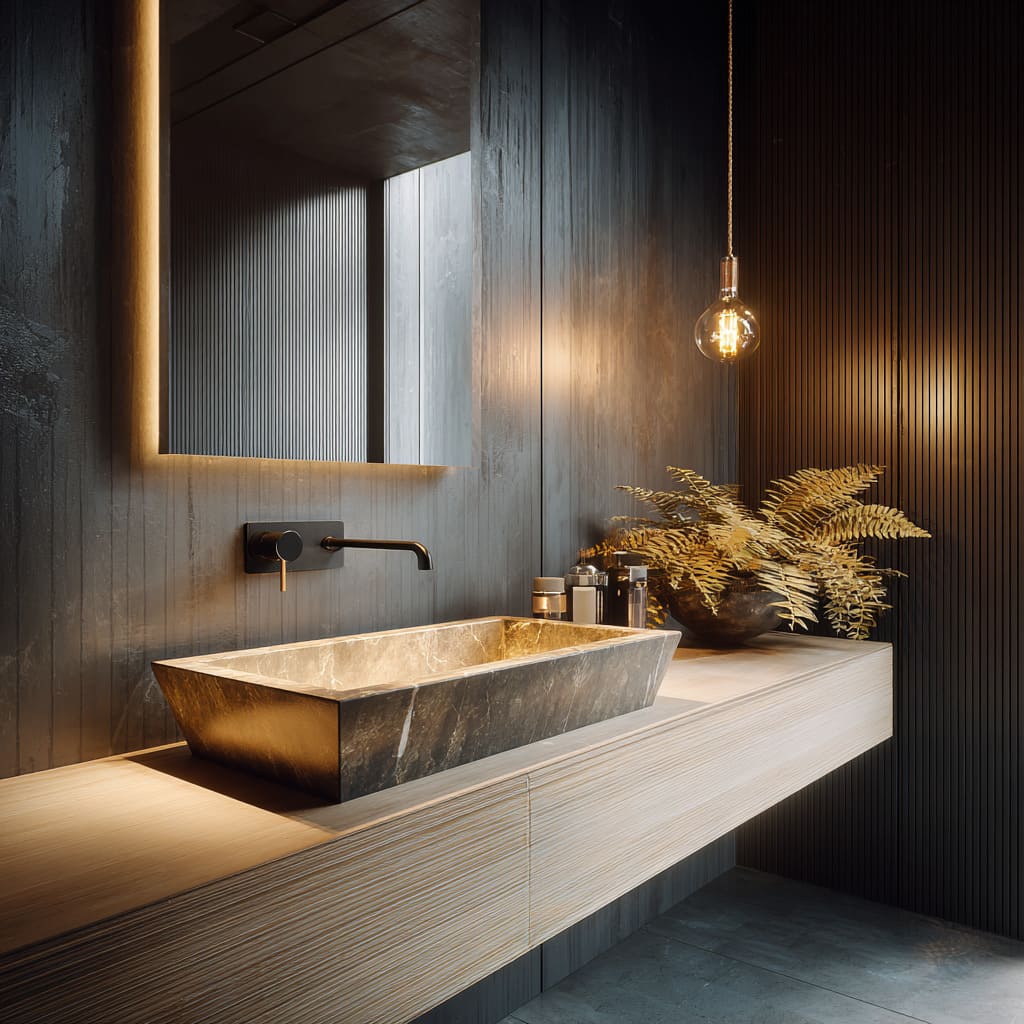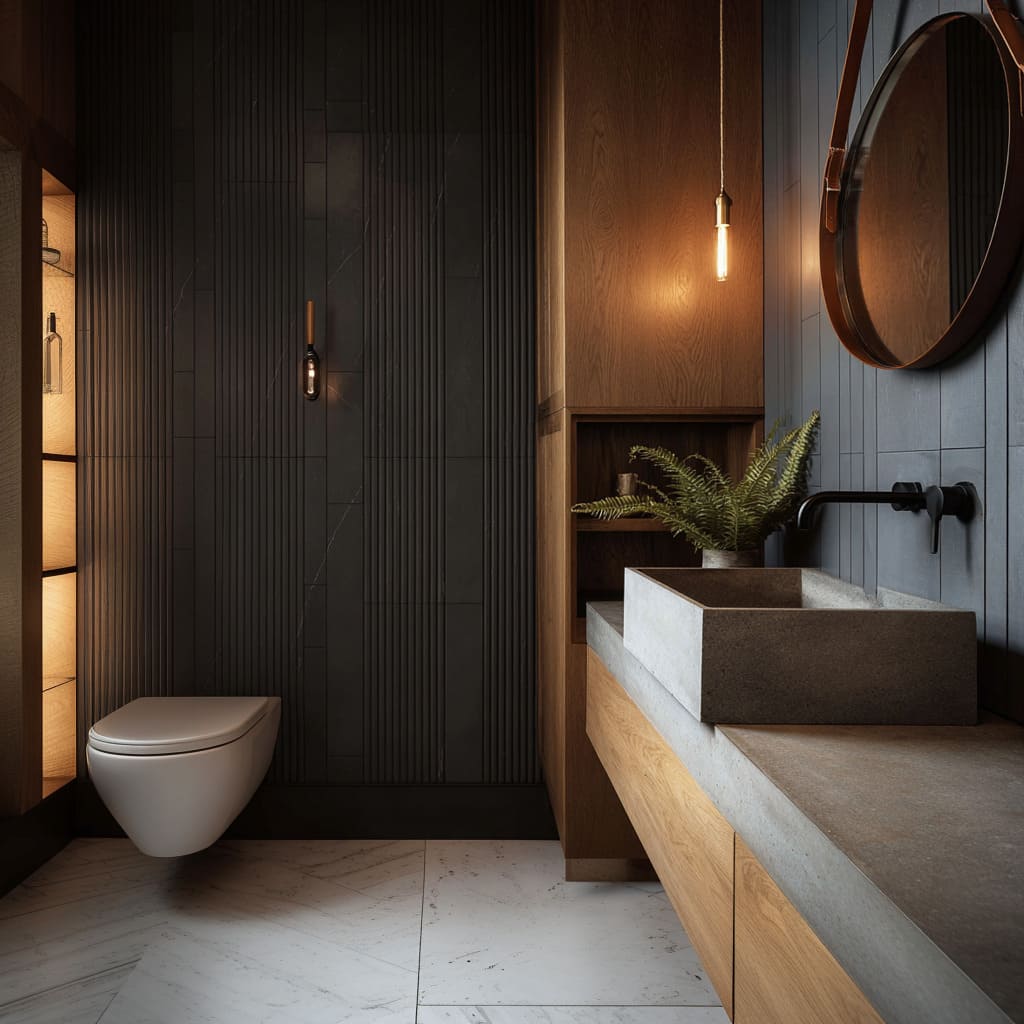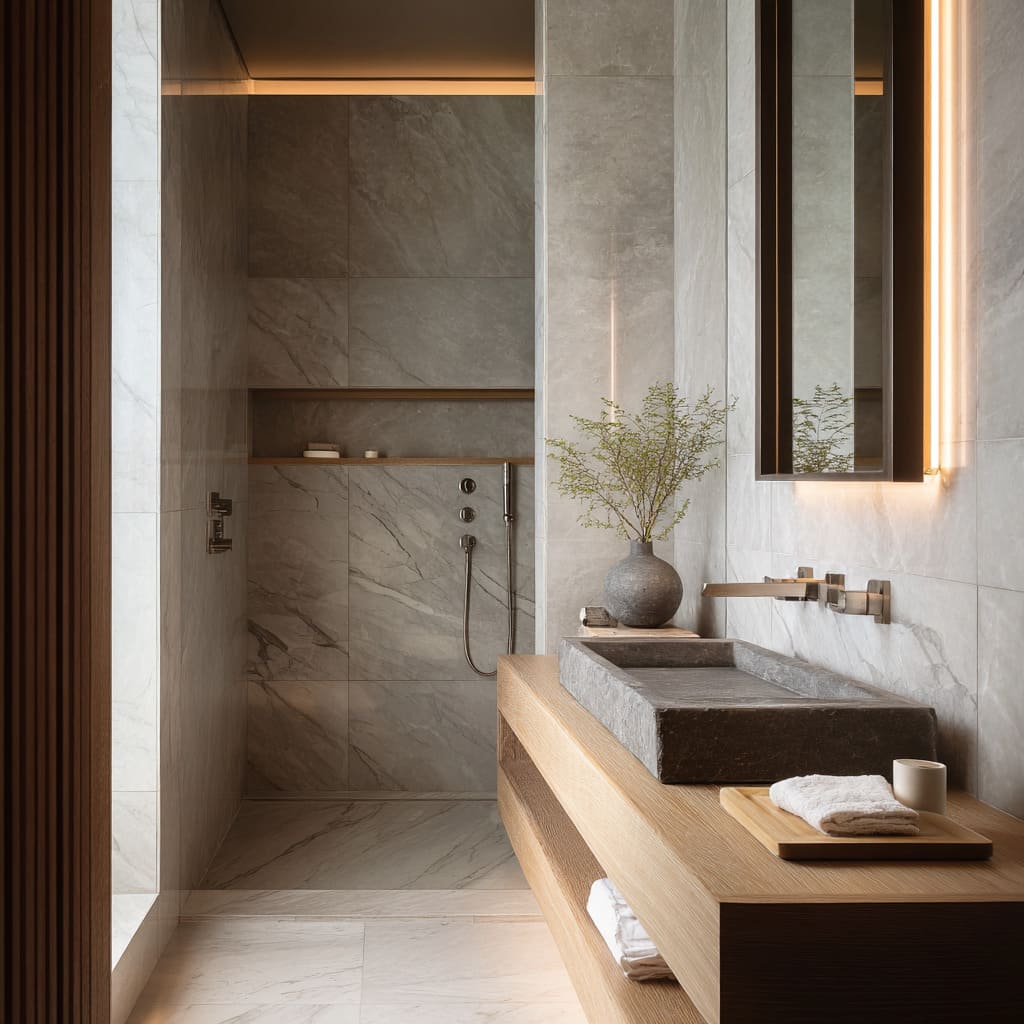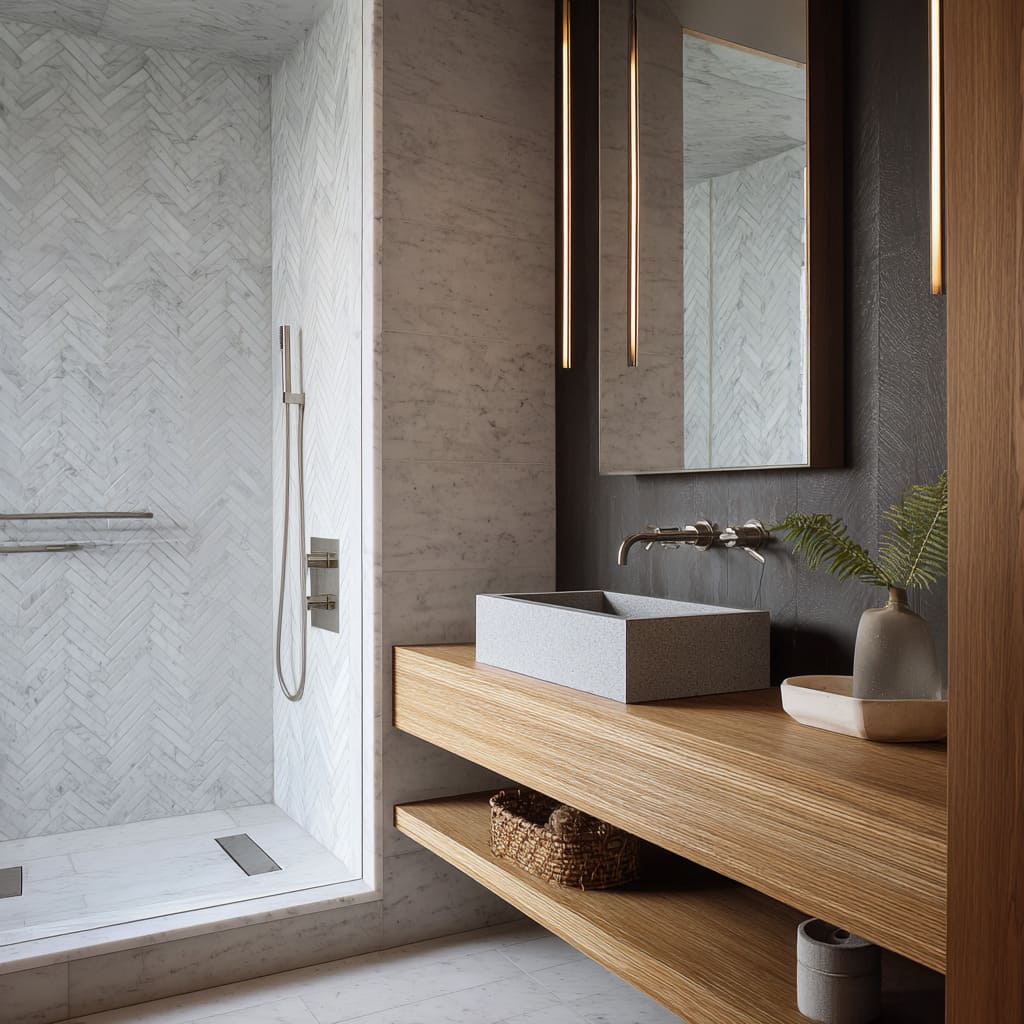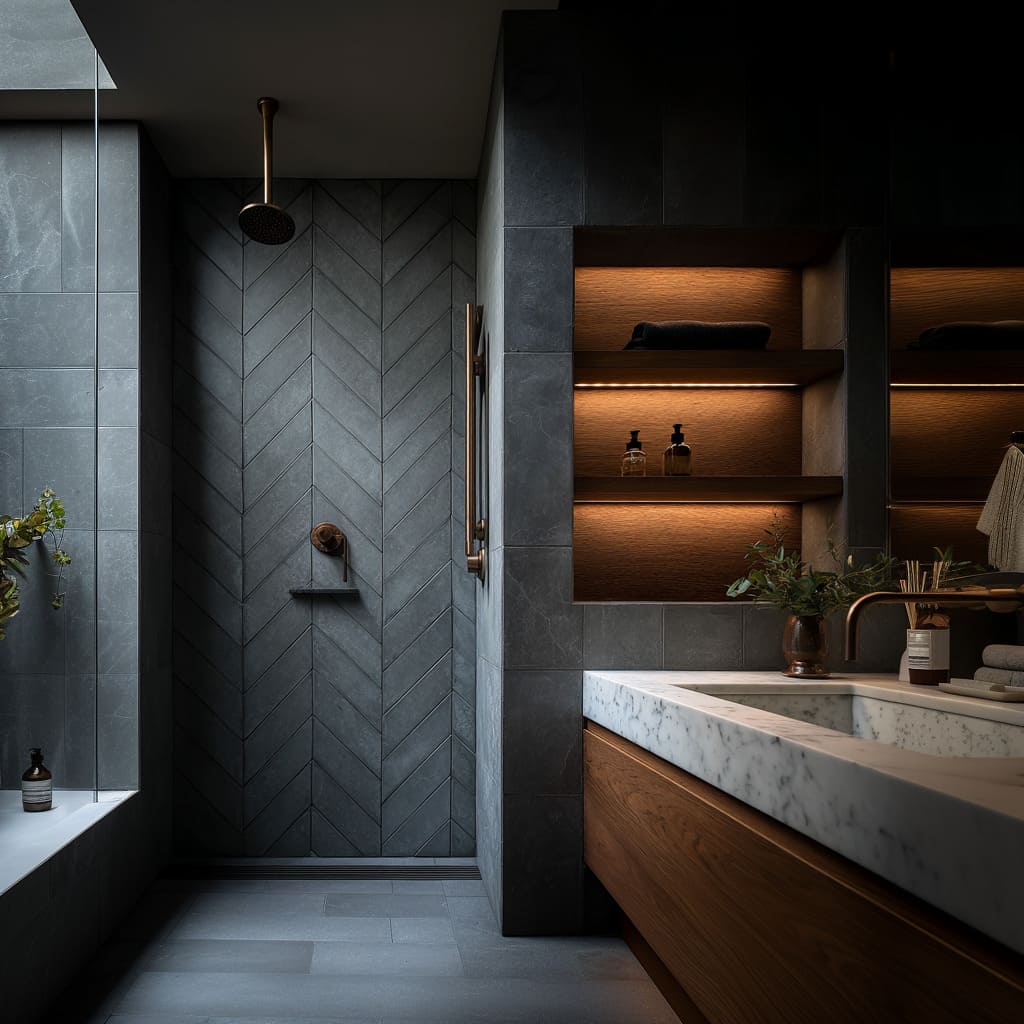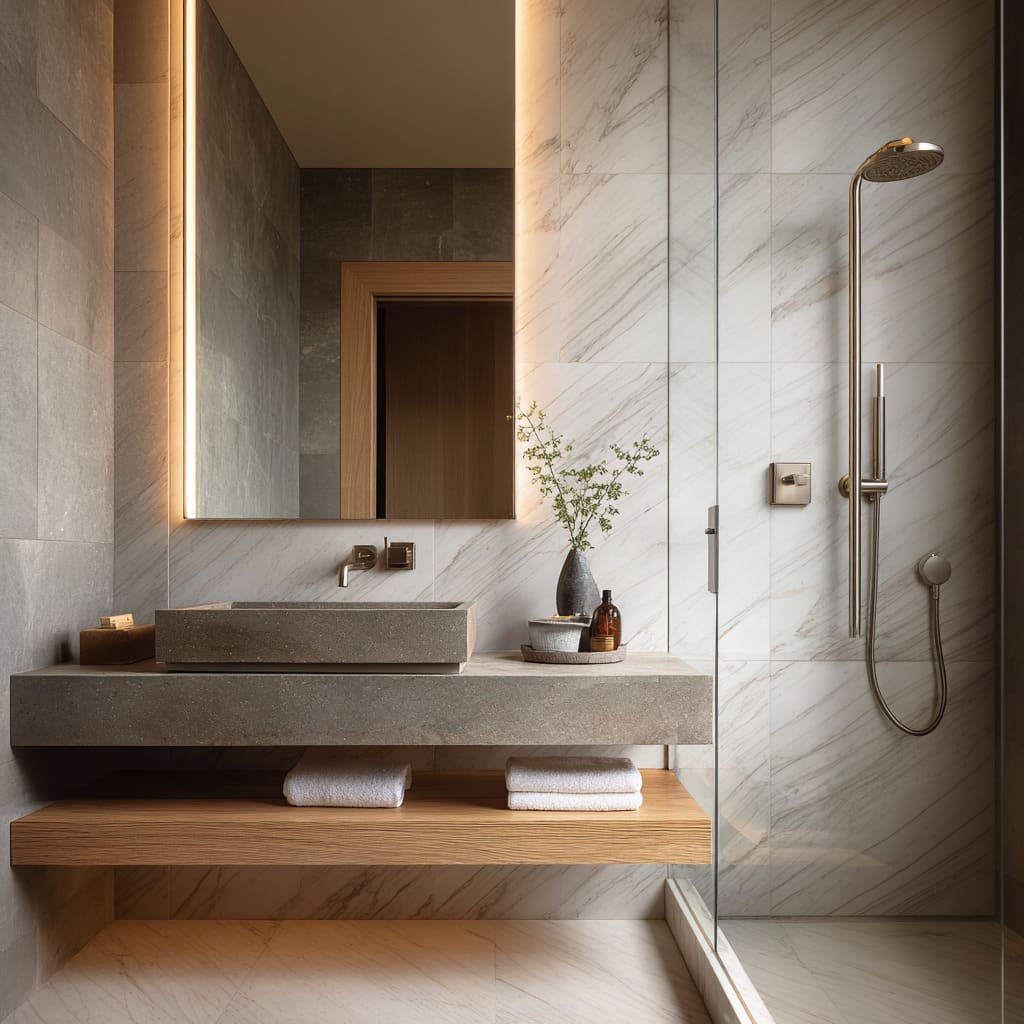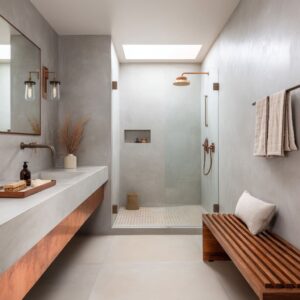Luxury bathroom designs today are defined less by visible wealth and more by precision. Surfaces are treated like sentences—measured, clear, and rhythmic.
Every plane carries purpose.
In modern luxury bathroom design, proportion and light work as the grammar of elegance.
Thick vanity slabs, wafer-thin fixtures, and sharp alignments create a dialogue of weight and lift. Marble or limestone walls, often uninterrupted, extend from floor to ceiling with controlled veins guiding the gaze.
Each joint aligns to something—mirror edge, faucet axis, or shelf line—so geometry becomes the invisible designer. The visual peace comes not from emptiness but from hierarchy: mass below, light above, quiet rhythm in between.
The eye glides across stone and timber bands as though reading music written in shadow and reflection.
Stone Treated as Architecture, Not Surface
Marble and stone behave differently when they are part of the room’s structure rather than decoration. In luxury modern bathroom designs, stone wraps the space like a shell—floors, walls, and vanity tops belonging to one continuous field.
- Horizontal veins establish a calm base and stretch the space visually.
- Vertical or feathered patterns add gentle movement without noise.
- Changes in tile layout—herringbone, chevron, or stacked—replace color shifts to mark functions.
This level of restraint turns veining into texture, not ornament. The most refined rooms appear carved from a single block, each line deliberate, every transition softened by light instead of trim.
Wood as the Temperature of Emotion
Natural timber and wood looking tile introduce warmth exactly where touch occurs: drawer fronts, mirror frames, shower portals. Oak and walnut are chosen not only for tone but for grain direction and how they speak to stone.
In small modern luxury bathroom design, wood becomes essential—it breaks the hardness of mineral surfaces without crowding space.
- Horizontal grain lines stretch the eye across the width of the room.
- Vertical fins or screens add privacy while keeping airflow and light.
- Matte finishes prevent reflection, letting light wash gently over the texture.
Wood isn’t an accent; it’s the heartbeat that gives comfort to the cold discipline of stone.
The Precision of Metal as Quiet Grammar
Metals are not loud. Polished chrome belongs to another decade; now, warmth is found in restraint.
Brushed brass, graphite, blackened nickel, or soft bronze appear in fine profiles—slim spouts, thin mixer plates, and small pendant caps. Luxury modern master bathroom designs use metal as punctuation.
Each piece sits on a strict centerline, perfectly scaled to the surface behind it. The tone of the finish follows the palette: warm brass beside walnut, smoky graphite beside pale marble.
The result is a whisper of sophistication—metal as highlight, not headline.
Light as a Drawing Tool
Light defines how materials breathe. In ultra modern luxury bathroom design, the goal is not brightness but composition.
Designers treat lighting as a drawing system made from lines, halos, and glows.
Layers of Illumination
- Perimeter glow around mirrors – creates a floating panel of light that replaces bulky sconces.
- Vertical blades or side strips – graze fluted walls, revealing texture through shadow gradients.
- Under-shelf and toe-kick lighting – separates mass from ground, letting stone float weightlessly.
- Warm pendants – add intimacy, softening the architecture with a human-scale glow.
The color temperature hierarchy is intentional: neutral around the mirror for clarity, warmer at the sides for comfort, cooler from above for balance. Light becomes drawing, not illumination.
The Art of Texture and Micro-Relief
Surface variation is the quietest kind of luxury. Fluted cladding, hand-troweled plaster, and honed marble add subtle depth to monochrome palettes.
Instead of color contrast, designers rely on light behavior—how it grazes, pools, or fades. Even the smallest grooves create atmosphere.
Ribbed tile fields scatter reflections; brushed stone and matte concrete absorb brightness; rough-faced basins on smooth counters make the hand register quality instantly. Luxury, in this sense, is tactile silence.
Negative Space as a Material
What’s missing is as important as what remains. Open shelves are recessed deep enough for shadows, and long stretches of marble are left untouched by décor.
Accessories are sparse—one stem, one folded towel, one amber bottle. This emptiness isn’t minimalism for its own sake.
It’s the visual oxygen that allows mass and light to perform. In modern luxury bathroom ideas, emptiness becomes the medium of calm.
The Play of Asymmetry and Balance
Many contemporary luxury bathroom designs rely on controlled imbalance. A pendant falls to one side of the mirror, reflected twice to create rhythm.
A plant offsets a basin’s axis, its organic line countering hard geometry. The difference between imbalance and chaos is structure: all these asymmetries occur inside an invisible grid.
They make the space feel lived-in, not staged. The viewer senses artistry, not perfectionism.
Objects That Behave Like Architecture
Decorative items echo the same discipline as the architecture that holds them. Vessels, trays, bottles, and vases repeat the geometry of basins and counters.
Their finishes—matte ceramics, smoked glass, brushed amber—sit within the room’s color logic.
The Micro-Scale Rules
- No reflective labels or bright caps.
- Shapes echo architectural lines: round vases where curves appear, rectangles where slabs dominate.
- Greenery is airy, never dense; single stems trace the light instead of blocking it.
Each item supports the architectural rhythm, turning accessories into a continuation of the design rather than a break from it.
Chromatic Calm: How Color Works Without Color
The tonal spectrum is narrow but rich in temperature shifts. Designers play with value rather than hue: stone veining, wood undertones, metal warmth, and light gradients create movement.
Common pairings include:.
- Pale marble + oak + champagne metal for daylight softness.
- Charcoal plaster + walnut + brass for cocooned warmth.
- Grey stone + beige vessel + black fittings for contemporary neutrality.
Color here is behavior, not pigment—it’s how surfaces interact with light and each other. That is why even the most neutral bathroom design can feel layered and alive.
The Psychology of Weight and Float
Thickness communicates confidence. Floating masses communicate freedom.
The constant push-pull between these sensations defines the modern aesthetic. Vanities appear solid enough to ground the eye, yet hidden gaps make them hover.
Basins are tall blocks balanced by thin mirrors. Heavy materials rest on invisible light lines.
The viewer perceives comfort and precision simultaneously. This sculptural rhythm of “mass versus void” gives small room layouts grandeur without adding scale—an essential idea in small modern luxury bathroom design.
Light as Mood, Shadow as Material
Soft shadows are the silent luxury. Their placement defines whether a bathroom design feels cold or inviting.
Shadows under benches or behind mirrors describe depth; shadows between tile joints or ribs add rhythm. Instead of overhead glare, they now compose shadow architecture—a subtle choreography where brightness has edges, and edges have tone.
This awareness transforms plain surfaces into living compositions.
From Composition to Character
Every design example shares one motive: coherence. Stone, wood, metal, and light are not layered decoratively; they form a single organism.
Whether in modern luxury bathroom design or its variations, the success lies in the discipline of visual rhythm—thick against thin, warm against cool, heavy against weightless.
The result feels effortless, but that effort hides in unseen order: veins matched, heights repeated, glows balanced, and reflections anticipated.
Luxury, in this language, is not loudness—it is precision quiet enough to hear the sound of materials thinking.

